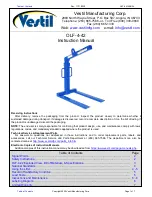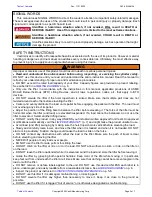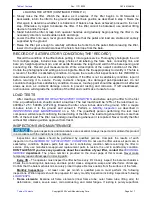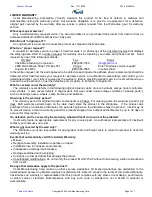
Rev. 11/11/2020
OLF-4 MANUAL
Copyright 2020 Vestil Manufacturing Corp. Page 5 of 7
LOADING THE LIFTER (CONTINUED FROM P. 4)
4. Slowly raise the lifter. Watch the device as it elevates. If the lifter begins to tilt forwards or
backwards, return the lifter to the ground and adjust bale position as described in step 3. Raise the
lifter again to determine whether it is balanced. If balance has been achieved, proceed to the next
step. Otherwise, try again to balance the lifter. If the lifter cannot be balanced, use another lifting
device to handle the load.
5. Stand behind the lifter. Grasp both operator handles and gradually begin pushing the lifter in the
necessary direction. Avoid sudden starts and stops.
6. Lower the lifter onto even, level ground. Make sure that the pallet and load are stable and entirely
supported by the ground.
7. Raise the lifter just enough to carefully withdraw the forks from the pallet. Before leaving the lifter,
lower it to the ground and disconnect the hoist chain/rope from the bale.
RECORD OF SATISFACTORY CONDITION (THE “RECORD”)
Record the condition of the lifter before putting it into regular service. Thoroughly photograph the unit
from multiple angles. Include close range photos of all labeling, the forks, bale, connecting link, and
bale pin, height adjustment pin, and all welds. Measure the length and width of the bale opening and
connecting link. Record your measurements. Write a description of the overall condition of the lifter.
Collate the photographs and writings into a single file. Mark the file appropriately to identify it. The file is
a record of the lifter in satisfactory condition. Compare the results of all inspections to this
RECORD
to
determine whether the unit is in satisfactory condition. If the lifter is not in satisfactory condition, repair it
before returning it to service. Purely cosmetic changes, like damaged paint/powdercoat, do not
constitute changes from satisfactory condition. However, touchup paint should be applied to all affected
areas as soon as cosmetic damage occurs to prevent rusting and corrosion. If left unaddressed,
rust/corrosion will degrade the condition of the lifter and could make it unsafe to use.
LOAD TESTS
RECORD OF SATISFACTORY CONDITION
efore using the lifter for the first
time, a qualified person should conduct a load test. The test load should be 125% of the rated load, i.e.
4000lb.x1.25 = 5000lb. (2272.7kg). Elevate the lifter a few inches above the ground. After a couple
minutes, return it to the ground and unload it. Perform a
on p. 5-6. The (qualified) person performing the test must
compose a written report confirming the load rating of the lifter. The load rating should not be more than
80% of the test load. The lifter must undergo load testing whenever it is repaired. Never modify the lifter
without first obtaining written approval from Vestil.
INSPECTIONS AND MAINTENANCE
Regular inspections and maintenance are essential. Always inspect and maintain this product
in accordance with the instructions in this manual.
Inspections and repairs should be performed by qualified persons. Compare the results of each
inspection to the
. Do not use the lifter unless all parts are in
satisfactory condition. Replace parts that are not in satisfactory condition before returning the lifter to
service. Only use manufacturer-approved replacement parts to restore the unit to satisfactory condition.
DON’T GUESS!
If you have any questions about the condition of your lifter, contact the
department.
The phone number is provided on the cover page of this manual.
Never make
temporary repairs of damaged or missing parts
.
Every lift
– The operator must inspect the lifter before every lift. Closely inspect the bale mechanisms.
Check the connecting link, bale loop, and bale pin for cracks, elongation, warps, and other forms of damage.
Confirm that the bale mechanism is securely pinned in place. Remove debris from the surfaces of the forks.
Monthly Inspections
– At least once per month a qualified person must perform the following
inspections. Written reports should be prepared for every monthly inspection including inspections following
1.
Frame elements:
Examine all frame elements (inner frame tube; outer frame tube; lifting arm) for
deformation, cracks, severe wear, corrosion/rusting, and metal fatigue. If rusting is purely superficial,

























